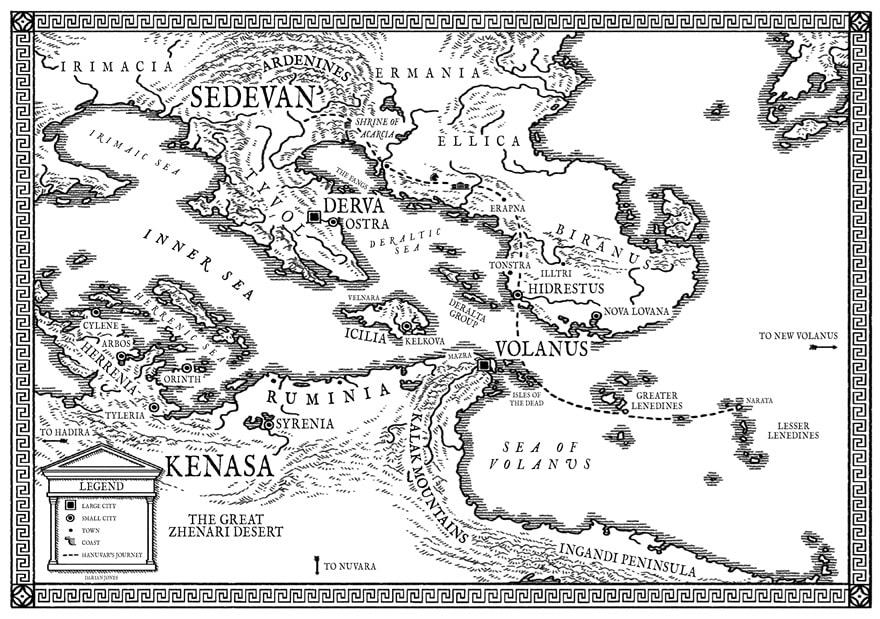Neverwhens: Hannibals’ Ghost(s) roams a City of Marble and Blood and a Genre is Reborn
The Chronicles of Hanuvar: Lord of a Shattered Land and The City of Marble and Blood
by Howard Andrew Jones (Baen, August 1, 2023 and October 3, 2023). Covers by Dave Seeley
Friends, Carthaginians, Dog-Brothers, I come to praise Howard Andrew Jones, not to bury him…
That was a lot of mixed-metaphors, but Howard’s mixed a lot of themes, tropes and reached back into the very roots of early heroic fantasy in his Chronicles of Hanuvar to breathe new life into what was considered a dead sub-genre, so perhaps appropriating Marcus Antonius’s funeral oration for Caesar and mentioning the Republic’s greatest rivals is appropriate.
Howard Andrew Jones is the leading Sword & Sorcery author of the 21st Century, and the growing saga of Hannuvar of Volanus (promised to be a five-volume series by Baen books) is his masterwork. The saga is the story of Hanuvar, the aging, last general of Volanus. Once a great city-state and naval power, Volanus has fallen to the legions and sorcery or the aggressive Dervan Empire.
Determined to make Volanus an object lesson to other nations, Derva leveled the city, scattered its stones, and carried its remaining survivors away in chains. But Derva has not reckoned with Hanuvar.
Believed dead, left with nothing besides decades of practical military lore and a grim determination, the greatest war-leader of the era slips into the empire alone and friendless, determined to free every last one of his people and bring them to a new home. Along the way, Hanuvar will deal with a dragon, confront otherworld horrors that would make H.P. Lovecraft shudder, become a member of a traveling carnival, match wits and blows with a twisted Dervan general, and cross much of the Empire to lead a tribe of northern barbarians in a desperate and terrifying battle against a magically transformed legion.
(And that is only volume one, Lord of a Shattered Land, which I am not even focused on in this review!)
The Hannuvar saga is the stuff of epics, and students of history will immediately recognize that they are reading a kind of alternate history in which Hannibal of Carthage lived to see his beloved city fall and returns to rescue his people from Rome. THAT would be a tale worth telling all on its own, but Jones, as both a lover of history and of the pulse-pounding, blood-and-thunder sword & sorcery of the pulp era has gone much further. His Volanus and Derva are NOT just Carthage and Rome; they are richly developed lands, and each time the reader believes they know just how these analog societies work, there is a twist or turn to catch them (pleasantly) off-guard.
Map by Darian Jones
While this is the sort of blood-and-thunder, fast-paced sword & sorcery not seen from a major publisher in DECADES, Lord is also a carefully, chronologically consistent tale painted with an epic and deliberate brush. This column grew from discussing world-building, so let’s start there.
Jones is a history nerd and the devoted editor of the Harold Lamb library (indeed, it is Lamb’s own history of Hannibal that began his love with the man and period). As such, his world isn’t the Rome of cheap 1960s peplum-film, where what is Rome today could be Troy tomorrow and Athens on Thursday, but a full-realized creation we learn about gradually. Derva is not the Republic, which destroyed Carthage, but an Empire, similar to that at the last days of Augustus; and the institutions are far more those of the imperium than the Republic.
There are elements of Nazi Germany’s Gestapo and SS that provide Indiana Jonese-esque villains, but also carefully drawn tribes and client states that would be more at home in the work of Talbot Mundy, writing a century ago, or modern historical fiction Romanophiles like Simon Scarrow. Derva and the nations surrounding isn’t a sketch; it is a secondary world that can only exist if the author understands the primary world he is mimicking and is making his changes and tweaks with great deliberateness.
Sword & Sorcery — that venerable genre, so often referenced, so largely ignored for decades now, is best when it is fast, breathy, and has goals that are immediate, but Jones is also telling a longer tale of a man out to save his people. He achieves this uniquely by using a newer medium, long-form, serial television, to inform the old. The Hannuvar novels are episodic, each chapter being a novelette, but with recurring characters and overarching plot arcs and themes. So, like a good Netflix show, the reader can ‘binge read’ the collection, or more leisurely ‘visit’ Hanuvar for one or two adventures and then return.
Like all sword & sorcery, the stories are filled with action, but it is married to themes that are far more adult, more ambitious and thought-provoking, than sword & sorcery is usually credited with. Hanuvar is a man of deep feeling and thought; an aging man who has grown children and a lifetime of allies and enemies spread across his world. We are meeting him at the twilight of his career, and yet his determination burns like the fires of the lighthouse of Alexandria. This first volume is a roller-coaster of wildly different adventures that leaves Hanuvar on the cusp of a major decision, and we the readers clamoring for more.
The second volume of Chronicles of Hanuvar takes our hero, and the sword & sorcery genre, someplace it has never gone before, and in a genre now hitting the century mark that is hard to do.
Much as, in the 1960s, a young Michael Moorcock took the war of Law and Chaos and the cursed sword Tyrfing from Poul Anderson, and married those ideas to a direct inversion of Robert E. Howard’s Conan to create Elric of Melnibone, Jones begun his tale of Hanuvar on solid, S&S ground: alternate history (in this case, a thinly-veiled alternate Hannibal of Carthage vs. an Augustan-era Rome); the short story fix-up novel (where a series of short stories, many previously published, are linked into a novel by some sort of device); and the collection of monsters, demons and other-worldly horrors that give an oblique nod to Lovecraft and Clark Ashton Smith.
As one can see in my review of the first volume, that is not criticism: that sort of work has been dormant for decades, and Jones infused his work with modern style and sensibility, tight prose and a hero who is — wait for it — heroic.
Further, whereas so many S&S heroes, and their lineal descendants in grimdark fiction, are motivated by either base desires, momentary needs, or revenge, Hannibal is motivated by the purest of motives: to find the last of his countrymen, wherever they may be, and secret them out of slavery and to a new city he is building on a distant island. It was good stuff, well-done and expertly told.
But here, Jones is off-book.
The referenced City of Marble and Blood is Derva itself, and much of the action happens in and around the capital or its nearby port. As in the first novel, each chapter is really a standalone story, linked by commentary from Hanuvar’s chronicler (actually commentary on the commentary, in good, faux academic style!), but this is not a fix-up novel. Much like a season of a television show, there is an overarching metaplot that tightly links each chapter-story together:
Hanuvar launches his plan to find and free the surviving Volani, but during an early adventure a terrible spell with an inept sorcerer goes awry, and what first seems an unexpected gift of renewed youth and vigor soon points to a swiftly approaching doom.
By having this novel-length metaplot carefully in mind, Jones can maintain the fast-paced adventures of the short story/novelette, where sword & sorcery shines, while also telling a more compelling tale. Recurring characters can enter and exit the novel’s larger story as appropriate, instead of being relegated to ‘special guest star of the week’ status, and he is also freed from the need to have every story feature some magical nemesis or malefic horror: some of these stories feature Scarlett Pimpernel-style plots, others swashbuckling but no sorcery, while others very much focus on the politics at play. But have no fear, there is plenty of sorcery for the sword and sorcery reader; simply, Jones is creating a balanced novel that feels like a coherent story rather than a breathy run from one unrelated caper to another.
And that is where Volume 2 exceeds its predecessor: this is not a fix-up novel in any way — it is an episodic novel, as a Sabatini or Dumas might have written, but told in a modern way, and cleverly realizing that the rise of long-form, three to five season television programs has trained modern readers to understand the model. I salute Jones for figuring out a way to use TV to make reading more enticing! (Looks at teenage son lying on couch gaming and gets idea…)
There is really nothing quite like this in print now: sequential tales that take an old format (the fix-up or serialized novel), presented in a way modern readers are used to from a new medium and with several levels of world building, including a commentator, who periodically footnotes his ancestor’s commentaries on the original chronicles of Hannuvar.
This is a delightful book that fulfills the promise of the first volume and then exceeds it. I look forward to Volume 3 next year.
Greg Mele’s last article for us was a review of New Edge Sword & Sorcery Magazine #1.


Couple great reviews in a row, Greg. Thorough and fulfilling. Thanks!
Aw shucks, Jason! I’m reading a certain collection right now, so that might be next.